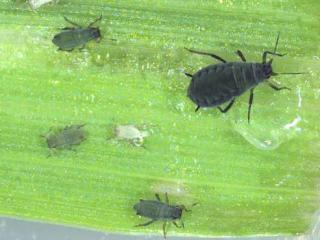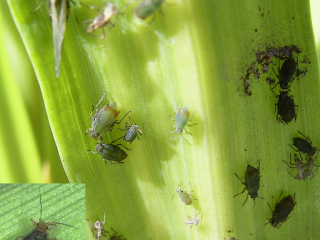A variety of cereal aphids are active
- Williams
- Boscabel
- Mount Barker
- Nyabing
- Needilup
- Jerramungup
- Lake Magenta
- Grass Patch
Adult Russian wheat aphids (RWA) have been found at low levels in early sown barley crops around Williams. The barley did not have a seed dressing.
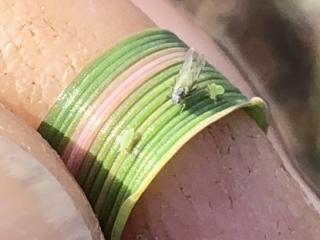
Theo Van Niekerk (Katanning Soil Nutrition Service) has found RWA on tillering Planet barley near Boscabel.
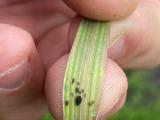
Kirsty Smith (Nutrien) has reported finding oat aphids, and a single RWA, in a barley crop near Mount Barker.
Adult RWA, and a mixture of larval stages of RWA, have been found on volunteer barley, in the leaf furl, near Nyabing.
Corn and oat aphids have recently been found in barley at the four leaf stage near Needilup.
Nicky Tesoriero (Ceres Agronomy) has recently reported finding RWA on a single plant in seedling Scepter wheat near Jerramungup. Nicky also found RWA, one aphid was winged, on seedling Scepter wheat near Lake Magenta.
RWA has also been found in tillering Denison wheat near Grass Patch. The crop didn’t receive a seed treatment.
Identifying cereal aphids
The three main cereal aphids in WA are corn aphids, oat aphids and the newly introduced RWA.
It is important that growers, consultants and agronomists correctly distinguish between cereal aphid species for effective aphid management.
Corn aphids are light green to dark olive green with darker patches at the base of the tube –like projections (siphuncles) on either side at the rear of the body.
Corn aphid colonies are often difficult to detect because they usually develop within the furled leaves of tillers any time from seedling to head emergence.
Oat aphids are the most abundant species of cereal aphids and vary from mottled yellow-green through olive-green and dusky brown, to a blackish green and are characterised by a reddish patch on the tip of the abdomen.
Oat aphid colonies develop on the outside of tillers from the base upwards on stems, nodes and backs of mature leaves, starting any time between seedling stage and grain filling.
For more information on diagnosing corn and oat aphids refer the department’s Diagnosing cereal aphids page.
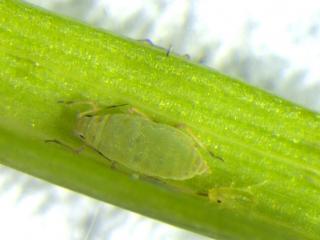
RWA adults are only about two millimetres long, pale yellowish green with a fine waxy coating. RWA antennae are short, and the siphunculi (sometimes called cornicles) do not extend from the back end. For more information refer to the DPIRD Diagnosing Russian wheat aphid page.
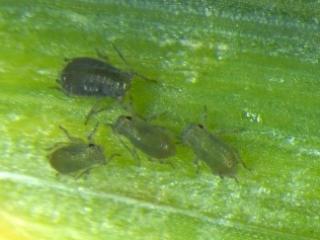
First to second instar nymphs of RWA and other cereal aphids can be particularly hard to identify so you do need a hand lens to look really closely.
Corn and oat aphids are vectors of barley yellow dwarf virus that reduces cereal yield. RWA is not a vector for viruses but during feeding RWA injects salivary toxins into plants which damages plant chloroplasts, causing striping on the leaf. The damaged tissue does not recover.
However for all cereal aphids (RWA, oat and corn aphid) yield impacts are dependent on the percentage of tillers with aphids.
Growers and consultants can use the PestFax Reporter app to request or confirm identification of aphids, or aphid damage to plants, that are found in crops.
Managing cereal aphids
Regular monitoring of cereal crops to determine changes in aphid populations and waiting until close to threshold levels of aphids before spraying is the recommended practice.
Crop inspections at several locations around cereal paddocks is recommended as aphid density will vary within crops. Look on the stems, undersides of leaves and in the furled growing tips for clusters of aphid colonies.
Walk in a ‘w’ pattern through the crop at each location, noting the number of tillers with aphids, every few paces. Consider counting at least 100 tillers at each location.
Direct feeding damage from aphids occurs when colonies of aphids develop on stems, leaves and heads, usually in the tillering and later stages of crop growth through to head filling. The degree of damage depends particularly on the percentage of tillers infested, the number of aphids per tiller and the duration of the infestation. If low numbers of aphids are observed, wait until threshold levels are reached before considering control options.
RWA thresholds are dependent on the crop stage, the time until head emergence, predicted yield and cost of spraying. A RWA threshold calculator is available on GRDC’s Russian wheat aphid page.
Barley crops are most at risk from corn and oat aphids due to the possibility of downgrading from malt to feed quality, as aphid feeding damage can cause grain shrivelling. If 50% of tillers have 15 or more aphids then the feeding damage may cause reductions in yields by up to 10% and also reduce grain size.
Keep in mind that naturally occurring parasitoids and predators such as wasps, lacewings and ladybird beetles will also increase with warming weather. These predators can keep aphid populations below threshold levels and un-necessary spraying of “anti-feed” synthetic pyrethroid sprays will only counteract their benefits.
When spraying, consider spray options that are soft (for example pirimicarb) on predators.
Also dense aphid colonies are prone to fungal pathogens. Aphids infected by fungi are sluggish and have white to yellow ‘fur’ covering their bodies. The fungus can readily spread throughout aphid colonies. The fungus can be more effective in decreasing aphid populations than chemical control.
For a list of insecticides registered for use on aphids (including RWA) see DPIRD’s 2021 autumn winter Insecticide Guide or refer to the Australian Pesticides and Veterinary Medicines Authority (APVMA) products database for all chemical control options available for RWA in grains crops.
For more information on cereal aphids, and recent RWA activity, refer to DPIRD’s:
- 2021 PestFax Issue 6 article Russian wheat aphids have progressed further west.
- Diagnosing cereal aphids page
- 2017 Protecting WA Crops Issue 3 newsletter Aphids – WA’s insect problem children.
For more information on aphids contact Svetlana Micic, Research scientist, Albany on +61 (0)8 9892 8591 or Alan Lord, Technical officer, South Perth on +61 (0)8 9368 3758.
Article authors: Cindy Webster (DPIRD Narrogin), Svetlana Micic (DPIRD Albany) and Alan Lord (DPIRD South Perth).

